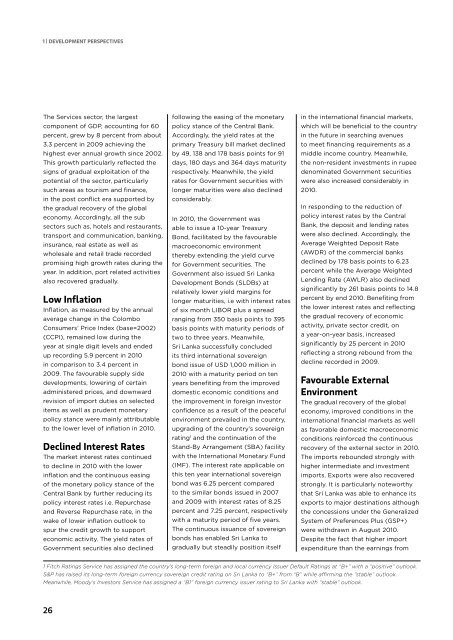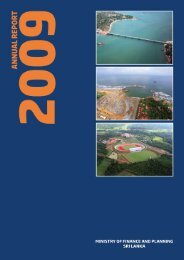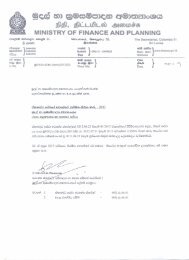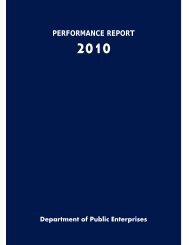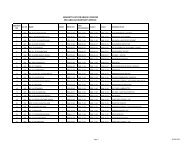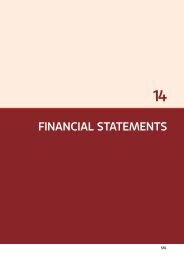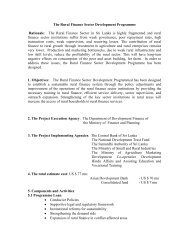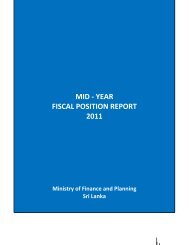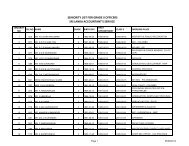Annual Report 2010 - Ministry of Finance and Planning
Annual Report 2010 - Ministry of Finance and Planning
Annual Report 2010 - Ministry of Finance and Planning
You also want an ePaper? Increase the reach of your titles
YUMPU automatically turns print PDFs into web optimized ePapers that Google loves.
1 | DEVELOPMENT PERSPECTIVESThe Services sector, the largestcomponent <strong>of</strong> GDP, accounting for 60percent, grew by 8 percent from about3.3 percent in 2009 achieving thehighest ever annual growth since 2002.This growth particularly reflected thesigns <strong>of</strong> gradual exploitation <strong>of</strong> thepotential <strong>of</strong> the sector, particularlysuch areas as tourism <strong>and</strong> finance,in the post conflict era supported bythe gradual recovery <strong>of</strong> the globaleconomy. Accordingly, all the subsectors such as, hotels <strong>and</strong> restaurants,transport <strong>and</strong> communication, banking,insurance, real estate as well aswholesale <strong>and</strong> retail trade recordedpromising high growth rates during theyear. In addition, port related activitiesalso recovered gradually.Low InflationInflation, as measured by the annualaverage change in the ColomboConsumers’ Price Index (base=2002)(CCPI), remained low during theyear at single digit levels <strong>and</strong> endedup recording 5.9 percent in <strong>2010</strong>in comparison to 3.4 percent in2009. The favourable supply sidedevelopments, lowering <strong>of</strong> certainadministered prices, <strong>and</strong> downwardrevision <strong>of</strong> import duties on selecteditems as well as prudent monetarypolicy stance were mainly attributableto the lower level <strong>of</strong> inflation in <strong>2010</strong>.Declined Interest RatesThe market interest rates continuedto decline in <strong>2010</strong> with the lowerinflation <strong>and</strong> the continuous easing<strong>of</strong> the monetary policy stance <strong>of</strong> theCentral Bank by further reducing itspolicy interest rates i.e. Repurchase<strong>and</strong> Reverse Repurchase rate, in thewake <strong>of</strong> lower inflation outlook tospur the credit growth to supporteconomic activity. The yield rates <strong>of</strong>Government securities also declinedfollowing the easing <strong>of</strong> the monetarypolicy stance <strong>of</strong> the Central Bank.Accordingly, the yield rates at theprimary Treasury bill market declinedby 49, 138 <strong>and</strong> 178 basis points for 91days, 180 days <strong>and</strong> 364 days maturityrespectively. Meanwhile, the yieldrates for Government securities withlonger maturities were also declinedconsiderably.In <strong>2010</strong>, the Government wasable to issue a 10-year TreasuryBond, facilitated by the favourablemacroeconomic environmentthereby extending the yield curvefor Government securities. TheGovernment also issued Sri LankaDevelopment Bonds (SLDBs) atrelatively lower yield margins forlonger maturities, i.e with interest rates<strong>of</strong> six month LIBOR plus a spreadranging from 350 basis points to 395basis points with maturity periods <strong>of</strong>two to three years. Meanwhile,Sri Lanka successfully concludedits third international sovereignbond issue <strong>of</strong> USD 1,000 million in<strong>2010</strong> with a maturity period on tenyears benefiting from the improveddomestic economic conditions <strong>and</strong>the improvement in foreign investorconfidence as a result <strong>of</strong> the peacefulenvironment prevailed in the country,upgrading <strong>of</strong> the country’s sovereignrating 1 <strong>and</strong> the continuation <strong>of</strong> theSt<strong>and</strong>-By Arrangement (SBA) facilitywith the International Monetary Fund(IMF). The interest rate applicable onthis ten year international sovereignbond was 6.25 percent comparedto the similar bonds issued in 2007<strong>and</strong> 2009 with interest rates <strong>of</strong> 8.25percent <strong>and</strong> 7.25 percent, respectivelywith a maturity period <strong>of</strong> five years.The continuous issuance <strong>of</strong> sovereignbonds has enabled Sri Lanka togradually but steadily position itselfin the international financial markets,which will be beneficial to the countryin the future in searching avenuesto meet financing requirements as amiddle income country. Meanwhile,the non-resident investments in rupeedenominated Government securitieswere also increased considerably in<strong>2010</strong>.In responding to the reduction <strong>of</strong>policy interest rates by the CentralBank, the deposit <strong>and</strong> lending rateswere also declined. Accordingly, theAverage Weighted Deposit Rate(AWDR) <strong>of</strong> the commercial banksdeclined by 178 basis points to 6.23percent while the Average WeightedLending Rate (AWLR) also declinedsignificantly by 261 basis points to 14.8percent by end <strong>2010</strong>. Benefiting fromthe lower interest rates <strong>and</strong> reflectingthe gradual recovery <strong>of</strong> economicactivity, private sector credit, ona year-on-year basis, increasedsignificantly by 25 percent in <strong>2010</strong>reflecting a strong rebound from thedecline recorded in 2009.Favourable ExternalEnvironmentThe gradual recovery <strong>of</strong> the globaleconomy, improved conditions in theinternational financial markets as wellas favorable domestic macroeconomicconditions reinforced the continuousrecovery <strong>of</strong> the external sector in <strong>2010</strong>.The imports rebounded strongly withhigher intermediate <strong>and</strong> investmentimports. Exports were also recoveredstrongly. It is particularly noteworthythat Sri Lanka was able to enhance itsexports to major destinations althoughthe concessions under the GeneralizedSystem <strong>of</strong> Preferences Plus (GSP+)were withdrawn in August <strong>2010</strong>.Despite the fact that higher importexpenditure than the earnings from1 Fitch Ratings Service has assigned the country’s long-term foreign <strong>and</strong> local currency Issuer Default Ratings at “B+” with a “positive” outlook.S&P has raised its long-term foreign currency sovereign credit rating on Sri Lanka to “B+” from “B” while affirming the ”stable” outlook.Meanwhile, Moody’s Investors Service has assigned a “B1” foreign currency issuer rating to Sri Lanka with “stable” outlook.26


